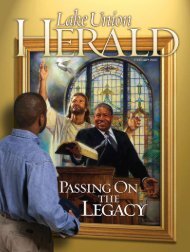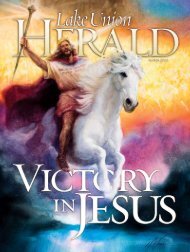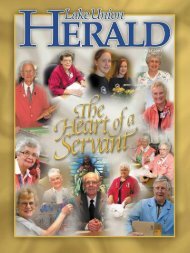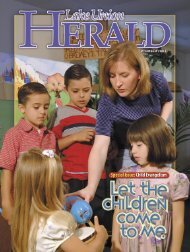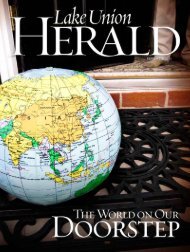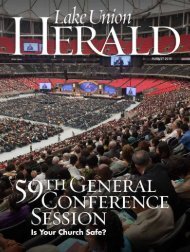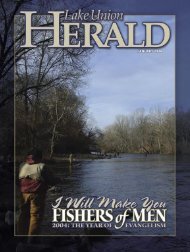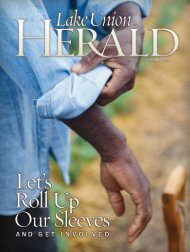YOUTHin Action - Lake Union Conference - General Conference of ...
YOUTHin Action - Lake Union Conference - General Conference of ...
YOUTHin Action - Lake Union Conference - General Conference of ...
You also want an ePaper? Increase the reach of your titles
YUMPU automatically turns print PDFs into web optimized ePapers that Google loves.
From left: Niels-Erik Andreasen, president <strong>of</strong> Andrews University, and Jan Paulsen, president <strong>of</strong> the Seventh-day Adventist World Church, answer questions about<br />
Adventist education during the “Rethinking Education” vespers held during the annual Fall Fellowship. This year Andrews University celebrates 50 years.<br />
Office <strong>of</strong> Integrated Marketing & Communication<br />
Emmanuel Missionary College<br />
In 1958, Emmanuel Missionary College (EMC) had been<br />
in Berrien Springs, Michigan, for 57 years. The school resided<br />
on about 400 acres, which included “rich farm land,” in<br />
what then-president Floyd O. Rittenhouse referred to as a<br />
“favored rural region.” Recent building achievements included<br />
a “modern, efficient milking parlor,” and plans were underway<br />
for a student center that would include new, updated<br />
dining services. It would be the first change in the cafeteria<br />
accommodations since the dining room was installed in the<br />
basement <strong>of</strong> the women’s dormitory in 1901. The campus<br />
was also abuzz with the near-completion <strong>of</strong> a brand new college<br />
church, rising on the southern edge <strong>of</strong> campus. The library<br />
housed a collection <strong>of</strong> 60,000 books, but was quickly<br />
outgrowing its home in what is today known as Griggs Hall.<br />
Of the dedicated faculty, 16 had doctorates and 40 held master’s<br />
degrees.<br />
In spite <strong>of</strong> its rural setting and the apparent slow pace <strong>of</strong><br />
EMC’s campus life, Rittenhouse noted, “Our campus far<br />
more closely resembles an anthill than a calm and quiet retreat.”<br />
In the fall <strong>of</strong> 1958, 929 students representing 23 countries<br />
were enrolled in the college. The student body reveled in the<br />
typical round <strong>of</strong> collegiate activities: the student paper, the<br />
yearbook, campus clubs, Ingathering, MV (missionary volunteer)<br />
bands, American Temperance Society orations, singing<br />
in the Collegians or playing in the EMC concert band, the<br />
SA (student association) banquet, the lyceum-concert series<br />
on Saturday nights and so on. In addition to pursuing a rich<br />
extracurricular life and their studies, the students worked<br />
all over campus—at the bindery, laundry, farm, college press<br />
and service station, to name just a few. Rittenhouse boasted<br />
that they earned more than half a million dollars in their oncampus<br />
work.<br />
And the world crept into the peaceful setting, as it always<br />
had. Rittenhouse reminded the <strong>Lake</strong> <strong>Union</strong> constituency<br />
that the campus was not completely isolated: “Influences<br />
<strong>of</strong> the cold war, the struggle over integration, labor difficulties,<br />
the decline <strong>of</strong> public and private morality, the portents<br />
<strong>of</strong> radically differing patterns <strong>of</strong> society under the aegis <strong>of</strong><br />
nuclear science and the space age, the competition for students<br />
on the part <strong>of</strong> well-financed, tax-supported colleges—<br />
all these things affect us.”<br />
The Seminary<br />
For the past 23 years, the Seventh-day Adventist Theological<br />
Seminary had been near the hub <strong>of</strong> the nation in Takoma<br />
Park, Maryland. A new Seminary building had been built on<br />
a lot behind the <strong>General</strong> <strong>Conference</strong> (World Church headquarters)<br />
and dedicated in January 1941, but by 1957 the<br />
building was already overflowing. Designed for a maximum<br />
enrollment <strong>of</strong> 140, it <strong>of</strong>ten accommodated around 200 students<br />
from 13 countries. Classes were held in the chapel and<br />
the Takoma Park Church. The carefully selected theological<br />
library, cared for by Mary Jane Mitchell, held an impressive<br />
43,000 volumes. It, too, was overflowing.<br />
In 1958 there was an influx <strong>of</strong> “fifth-year” ministerial students<br />
completing their extra year <strong>of</strong> training after college (a<br />
new church-wide requirement), but a majority <strong>of</strong> the students<br />
were mature church workers, many <strong>of</strong> them ordained,<br />
Washington Missionary College (Photo circa 1930s)<br />
Takoma Park Church (Photo circa 1950s)<br />
President Floyd O.<br />
Rittenhouse served as<br />
president during the<br />
tumultuous transition from<br />
EMC to Andrews University<br />
(1955-1963).<br />
Vi s i t w w w. L a k e Un i o n He r a l d . o r g L a k e U n i o n H e r a l d • Oc t o b e r 2 0 0 9 | 15





